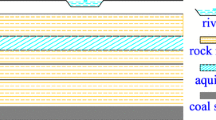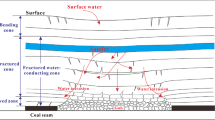Abstract
The accurate calculation of the height of water-flowing fractured zone (WFFZ) in coal mine is a critical factor in ensuring mine safety and protecting surficial eco-environment. In view of inapplicability of traditional empirical formula for predicting the height of WFFZ, the correlation of the height of WFFZ and influence factors was analyzed firstly based on 82 collected groups of coalfield measured data in China. Results show that the mining thickness and mining depth have a significant effect on the height of WFFZ. Subsequently, the measured data were divided into two parts: 80% for training models and the remaining 20% for validation. Two prediction models, i.e., the multiple regression (MR) model and BP neural network (BPNN) model, were established and trained. A new merging model, multiple regression-BP neural network (MR-BPNN) model, was proposed by combining the multiple regression and BP neural network model. The prediction accuracy and generalization ability of the three models were verified by the recorded testing samples. Results of comparison suggest that three models all had better applicability for predicting the height of WFFZ in the coalmine, compared with the existing empirical prediction methods. More importantly, the MR-BPNN merging model combined the nonlinear mapping ability of neural network and empiric of multiple regression model, which could provide high-accurate, strong-generalized, and practical application for predicting the height of WFFZ of coalfield. In addition, the reason for the inapplicability of traditional empirical formula and the practicability of the proposed neural network-based prediction models were discussed.












Similar content being viewed by others
References
Bruna PO, Straubhaar J, Prabhakaran R, Bertotti G, Bisdom K, Mariethoz G, Meda M (2019) A new methodology to train fracture network simulation using multiple-point statistics. Solid Earth 10(2):537–559
Cao YB, Feng XT, Yan EC, Chen G, Lu FF et al (2016) Calculation method and distribution characteristics of fracture hydraulic aperture from field experiments in fractured granite area. Rock Mech Rock Eng 49(5):1629–1647
Chang S, Yang Z, Guo CF, Ma ZY, Wu X (2019) Dynamic monitoring of the water flowing fractured zone during the mining process under a river. Appl Sci 9(1):43–61
Gao YF, Huang WP, Liu GL, Zhang SF, Zhu QM, Deng ZY (2012) The relationship between permeable fractured zone and rock stratum tensile deformation. J Min Saf Eng 29(3):301–306
Han B, Zdravković L, Stavroula K (2015) The stability investigation of the generalised - α time integration method for dynamic coupled consolidation analysis. Comput Geotech 64:83–95
Han B, Zdravković L, Stavroula K, Taborda DMG (2016) Numerical investigation of the response of the Yele rockfill dam during the 2008 Wenchuan Earthquake. Soil Dyn Earthq Eng 88:124–142
Hu XJ, Li WP, Cao DT, Liu MC (2012) Index of multiple factors and expected height of fully mechanized water flowing fractured zone. J China Coal Soc 37(4):613–620
Huan H (2016) Applying partial least squares regression to calculate the height of water flowing fractured zone. International Conference on Mechanical Manufacturing and Energy Engineering (ICMMEE), Changsha, China
Jo I (2018) World energy issues: an inquiry-based lesson using ArcGIS online. Geogr Teach 15(1):43–46
Khanal M, Adhikary D, Balusu R (2012) Numerical analysis and geotechnical assessment of mine scale model. Int J Min Sci Technol 22:693–698
Li P, Wu J, Qian H, Lyu X, Liu H (2014) Origin and assessment of groundwater pollution and associated health risk: a case study in an industrial park, northwest China. Environ Geochem Health 36(4):693–712
Li ZH, Xu YC, Li LF (2015) Forecast of the height of water flowing fractured zone based on BP neural networks. J Min Saf Eng 32(6):905–910
Li HJ, Chen QT, Shu ZY, Li L, Zhang YC (2018) On prevention and mechanism of bed separation water inrush for thick coal seams: a case study in China. Environ Earth Sci 77:759–770
Liu SL, Li WP (2019b) Zoning and management for phreatic water resources conservation impacted by underground coal mining: a case study in the arid and semiarid area. J Clean Prod 224:677–685
Liu SL, Li WP (2019c) Indicators sensitivity analysis for environmental engineering geological patterns caused by underground coal mining with integrating variable weight theory and improved matter-element extension model. Sci Total Environ 686:606–618
Liu XS, Tan YL, Ning JG, Tian C, Wang J (2015) The height of water conducting fractured zones in long wall mining of shallow coal seams. Geotech Geol Eng 33(3):693–700
Liu SL, Li WP, Wang QQ (2018a) Zoning method for environmental engineering geological patterns in underground coal mining areas. Sci Total Environ 634:1064–1076
Liu SL, Li WP, Wang QQ (2018b) Height of the water-flowing fractured zone of the Jurassic coal seam in northwestern China. Mine Water Environ 37(2):312–321
Liu SL, Li WP, Wang QQ, Pei YB (2018c) Investigation on mining-induced fractured zone height developed in different layers above Jurassic coal seam in western China. Arab J Geosci 11(30):2–10
Liu Y, Li WP, He JH, Liu SW, Cai LY, Cheng G (2018e) Application of Brillouin optical time domain reflectometry to dynamic monitoring of overburden deformation and failure caused by underground mining. Int J Rock Mech Min Sci 106:133–143
Liu SL, Li WP, Qiao W (2019) Effect of natural conditions and mining activities on vegetation variations in arid-semiarid mining areas. Ecol Indic 103:331–345
Miao XX, Cui XM, Wang JA (2011) The height of fractured water-conducting zone in undermined rock strata. Eng Geol 120:32–39
Ministry of Construction of the PRC and General Administration of quality supervision (2009) Inspection and quarantine of the PRC (2009) Code for geotechnical investigation. Beijing
National Coal Mine Safety Administration (2017) Regulations of buildings, water, railway and main well lane leaving coal pillar and press coal mining. Coal Industry Press, Beijing
Palchik V (2003) Formation of fractured zones in overburden due to longwall mining. Environ Geol 44:28–38
Piao CD, Wang D, Kang H, He H, Zhao C, Liu W (2019) Model test study on overburden settlement law in coal seam backfill mining based on fiber Bragg grating technology. Arab J Geosci 12(13):401–409
Rezaei M, Hossaini MF, Majdi A (2015) Development of a time-dependent energy model to calculate the mining-induced stress over gates and pillars. J Rock Mech Geotech Eng 7:306–317
Sui WH, Liu JY, Yang SG, Chen ZS, Hu YS (2011) Hydrogeological analysis and salvage of a deep coalmine after a groundwater inrush. Environ Earth Sci 62:735–749
Sun YJ, Xu ZM, Dong QH (2009a) Monitoring and simulation research on development of water flowing fractures for coal mining under xiaolangdi reservoir. Chin J Rock Mech Eng 28(2):238–245
Sun YP, Wang YF, Zheng XJ (2009b) Analysis the height of water conducted zone of coal seam roof based on GA-SVR. J China Coal Soc 34(12):1610–1615
Sun QX, Mou Y, Yang XL (2013) Study on “two-zone” height of overlying of fully-mechanized technology with high mining height at Hongliu Coal Mine. J China Coal Soc 38(a2):283–286
Wang LG, Wang ZS, Huang JH, Zhou DL (2012) Prediction on the height of water-flowing fractured zone for shallow seam covered with bedrock and thick windblown sands. J Min Saf Eng 29(5):607–612
Wang G, Wu M, Wang R, Xu H, Song X (2017) Height of the mining-induced fractured zone above a coal face. Eng Geol 216:140–152
Wang ZC, Wang C, Wang ZC (2018) The hazard analysis of water inrush of mining of thickness coal seam under reservoir based on entropy weight evaluation method. Geotech Geol Eng 36(5):3019–3028
Xie XF, Li XB, Shang XY, Weng L, Deng QL (2017) Prediction of height of water flowing fractured zone based on PCA-BP neural networks model. China Saf Sci J 27(3):100–105
Xing ML, Li WP, Yin JH (2017) Study on height prediction of water flowing fractured zone caused by full-mechanized caving mining in Jurassic coalfield. Saf Coal Mines 48(9):39–42
Zhang MS, Dang XY (2014) Water resources and environmental problems in arid and semi arid regions—analysis of Yulin energy and chemical base in northern Shaanxi. Science Press, Beijing
Zhang YJ, Li FM (2011) Monitoring analysis of fissure development evolution and height of overburden failure of high tension fully-mechanized caving mining. Chin J Rock Mech Eng 30(S1):2995–3001
Zhang DS, Fan GW, Ma LQ, Wang A, Liu YD (2009) Harmony of large-scale underground mining and surface ecological environment protection in desert district—a case study in Shendong mining area, northwest of China. Procedia Earth Planet Sci 1(1):1114–1120
Zhang HW, Zhu ZJ, Huo BJ (2013) Water flowing fractured zone height prediction based on improved FOA-SVM. China Saf Sci J 23(10):10–15
Zhang W, Zhang DS, Wu LX, Wang HZ (2014) On-site radon detection of mining-induced fractures from overlying strata to the surface: a case study of the Baoshan Coal Mine in China. Energies 7(12):8483–8507
Zhang Y, Ye JH, Ji HG, Wang JN (2016) Identifying the development of mining-induced fractures zone using dynamic stress tracing method. Rock Soil Mech 37(11):3291–3323
Funding
The authors wish to appreciate the financial supports provided by the National Natural Science Foundation of China (51979155), National Natural Science Foundation of Shandong Province (ZR2018QEE008), and Key Research and Development Plan of Shandong Province (2019GHY112078, 2019JZZY010429, 2019GSF11040).
Author information
Authors and Affiliations
Corresponding author
Additional information
Responsible Editor: Zeynal Abiddin Erguler
Rights and permissions
About this article
Cite this article
Dai, S., Han, B., Liu, S. et al. Neural network–based prediction methods for height of water-flowing fractured zone caused by underground coal mining. Arab J Geosci 13, 495 (2020). https://doi.org/10.1007/s12517-020-05505-5
Received:
Accepted:
Published:
DOI: https://doi.org/10.1007/s12517-020-05505-5




